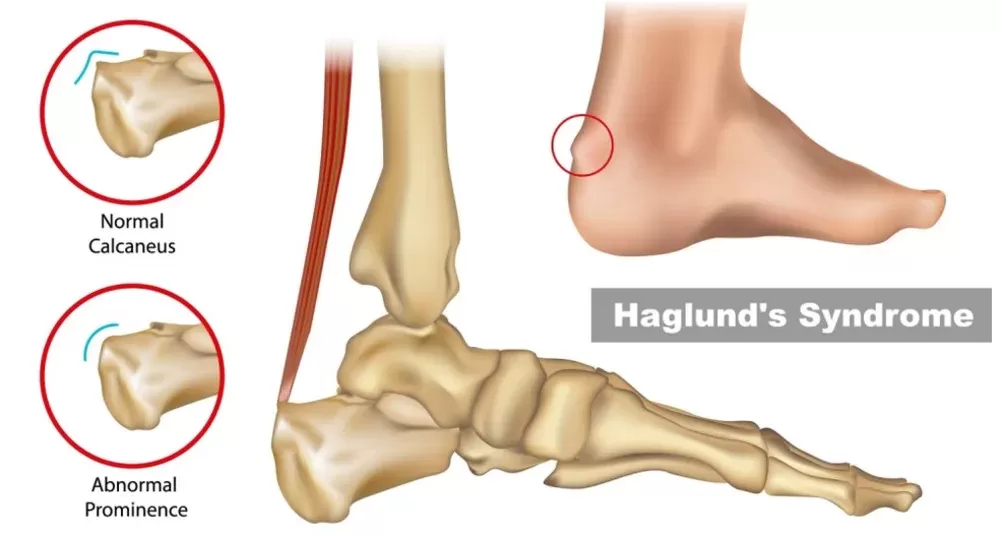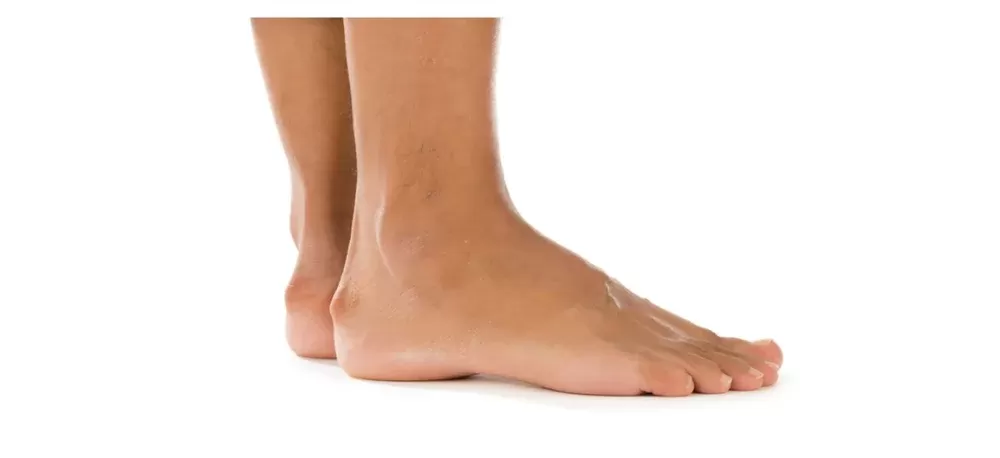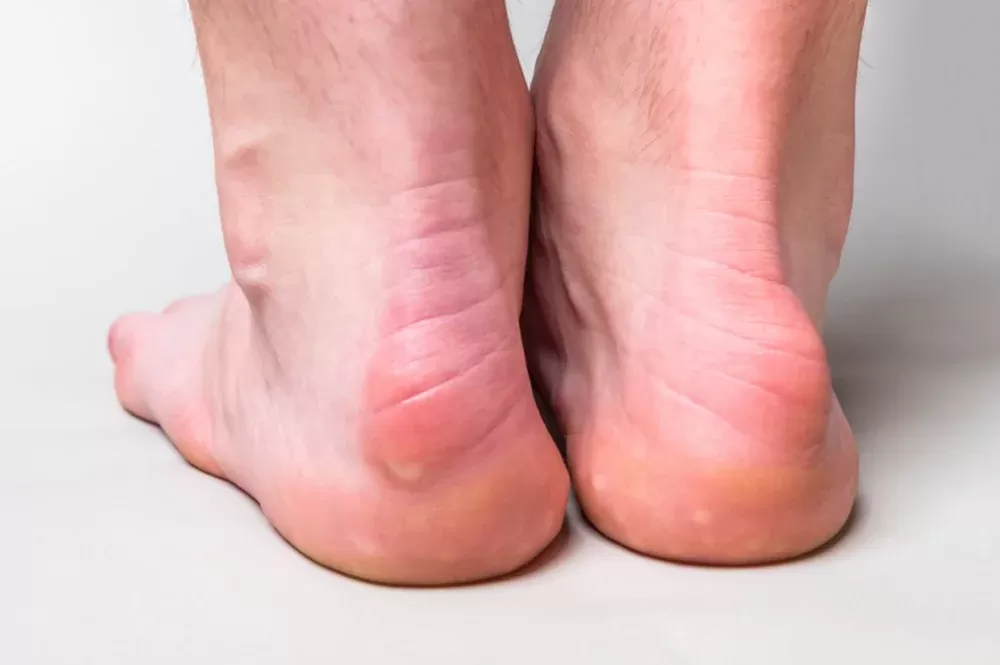What is Haglund's deformity: Treatment & Exercises
- Secondary Pain From Haglund’s Heel
- Solutions & Treatments For Haglund's Deformity In London
- Shoe choice for Haglund's deformity
- Treatment for Haglund's deformity
Haglund's deformity is a bony growth on the back of the heel. The soft tissue near the Achilles tendon becomes irritated when the bony enlargement rubs against the side or cup of footwear.
How Haglund's heel causes pain:
There are two stages to the pain journey:
1) The cause - The extra movement and consequential rubbing, and
2) Secondary issues - Secondary issues come after limping and altered biomechanics of the heel bone as compensation for accommodating an extra lump of bone in one heel in the later chronic stage.
Sadly, footwear is not designed to accommodate this extra bit of bone, partially once they get to a substantial chronic stage (typically, getting to this chronic requires 2-5 years of development but which may be silent, i.e. maybe painless).
When Pain From Haglund's Heel Is New:
Okay, so we must be careful here as the word: NEW! New can mean different things to different people. This is also the case for the word PAIN!, as pain is often on a spectrum, and some people handle pain better than others.
Because of the scope and sensation difference, we tend to find that clients say they have not ‘registered’ pain until the heel enlargement is significantly developed.

However, when we ask:
“Was there any sensitivity on the heel in specific shoes or that you modified around?” or “Was the reddening bump or swelling there before?”
They often reply,
“Yes, for many years”.
It is this primary question: regarding the sensitivity and presence of the bump, rather than moderate or severe pain, & when the bump and sensitivity started that would determine if NEW HEEL PAIN is the section for you;
SIDE NOTE: Typically, the mechanical issue starts in teens (around 14 y/o), so if you have a noticeable lump and are over 40 years old, maybe skip to the Secondary Pain Section:
At This NEW stage, the primary pain often comes from the bump itself, the skin of the node is irritated, and there is also a potential cyst-type formation to start, and blistering in hard shoes may be apparent. There is often high wear and tear to the heel of shoes, but that may also be noticed on trainers. This reaction may gravitate towards enduring irritation and what's known as Haglund's deformity.
Secondary Pain From Haglund’s Heel
Haglund's deformity often leads to painful swelling of th retrocalcaneal bursa at the lowest part of th heel cord. This is called heel bursitis, an inflammation of the bursa (a fluid-filled sac between the tendon and bone). This is typically central to the heel bone and adjacent to the bony enlargement site. Clients may also get non-insertional Achilles tendonitis that's associated with poor heel strike.
So If the Haglungs pain is all down to the rubbing of the heel bone, what's causing the rubbing?
Two things cause the rubbing in Haglund's heel deformity: You may be unlucky enough to have both causes together or just one at a time.
The first and most apparent is footwear; at the beginning of the condition, the footwear is often too loose and unsupportive around the heel. But remember you have to rub the area against SOMETHING, i.e. flip flops are unlikely to cause rubbing as there is nothing to rub together with the side of the heel. However, often there must be a stiff leather or plastic rubbing against the heel rubs against.

The second cause of the rubbing in this heel problem is the foot itself within the shoe:
The heel bone is usually inverted or inverted upon heel strike in walking or running. This means the heel cord and bone at its base are often leaning to the left or the right, and typically, the cause of this is their off-centre heel strike, which is common in runners. This is impacted by:
- Imbalances in the shin muscles.
- Overpronation of the midfoot or arch, otherwise known as flattened feet for flattening feet.
- Forefoot imbalance, i.e. bunions and bunionettes or wide feet.
Long and short: If enough dynamic movement of the foot goes on inside the shoe, you will get excessive rubbing. If this rubbing is not mediated, it potentially leads to heel deformity and later secondary issues.
Solutions & Treatments For Haglund's Deformity In London.
While surgery can be an option for the highly chronic, we find great success in conservative management mixed with sound wave technology. First and foremost, mindfulness about the foot (heel, midfoot, and even toe) strike position and footwear education are the best treatment solutions.
One of our specialists at the London Foot Pain Clinic can help you understand and master this condition so that you can take control of its development.
This might not be helpful if Haglund's deformity develops into the secondary and tertiary growth stages. But we have many clients who are fully functional/ painless in these stages, and there remains a big bump that changes the running and walking mechanics due to the size of the bump. To become one of these positive cases, a further reading below may help:

Shoe choice for Haglund's deformity
The phrase ‘dammed-if-you-do & dammed-if-you-do-not’ comes to mind here.
Sadly any type of shoe design will have positive and negative effects on Haglung’s heels. As a rule of thumb, we ask clients in a painless stage to cycle their shoe design and not stick with a single shoe.
Why do we say this?
With a hypermobile heel bone, there is bound to be movement; while some shoes and orthotic inserts may control this, their material rigidity accomplishes this. But as the material doesn't flow with poor heel control, there is the inevitable rub, and the consequence is irritation.
On the flip side, open-back shoes, crocs, and flip-flops often cause less rubbing but open up the dynamic heel bone to move more and loosen, creating further issues in the future.
We have found a blend of both works well depending on if the bump is inflamed (red) and tender or not.
Modern Shoes/ Trainers:
Of course, there are also more modern shoes, like Adidas Pod trainers. These have reasonably stable soles, but the heel and toe housing are elastic to allow a free-flow experience for the heel bone while giving a level of support.
These shoes are recommended over flip-flops or Crocs for Hadlungs heel pain, but the elastic tightness will be lost over time, so replace them every six months or so, depending on how many steps are done each day in them. It's best to link these shoes with a medical orthotic insert (prescription) to add further control from the underside to the foot. And, of course, you prescribe drill and rehab to tighten up your gait and foot strike while in the free-flow shoes.
SIDE NOTE: Be cautious. A free-flow shoe allows more wobble for the ankle and has a consequence for the knees, hips and lower back. Should you develop any of these, seek professional evaluation.
Treatment for Haglund's deformity
We’ve seen treatment options that work exceptionally well: Focused ESWT and Extracorporeal Shockwave Therapy (ESWT) are two modern methods.
This Focused ESWT is a sound wave drumming into the heel bone to allow it to recover at the side of the rub. While this doesn’t make the bump any smaller, it rapidly calms inflammation and propagates bone healing and sub-bone cyst repair.
We have noticed empirically in the clinic that ESWT treatment helped bring the clients out of a circle of pain and allowed them to start the PRICE principles and rehabilitation of gait and foot control.
Rehab for Haglund's heel Deformity
There are also several exercises and rehabilitation drills for clients to learn more about awareness of the foot; however, these don’t typically help in an excruciating/painful stage but are integral to starting as soon as possible.
Of course, the focused ESWT is done on top of the P.R.I.C.E principles, which stand for
- Protect (supports and taping),
- Rest,
- Ice,
- Compression,
- Elevation,
which should all be done at home as soon as you start to suffer.
Eccentric heel raises, and slow drops are probably well up there regarding the exercise of choice to 5. We have a secondary effect of Achilles tendinitis looming with Hadlungs, so educating about balance and centralising heel strike factors is essential.
SIDE NOTE: The rehab should be done barefoot to avoid further rubbing.
We talk further about heel strike education later in this article. We believe that education is foremost the most critical part. And it's worth trying some self-application before coming to the clinic for healing stimulation, stabilising orthotics and rehab refinement.
Support Treatment For Haglund's Deformity
There are two support methods: rolling heel bone, which may limit rubbing against the shoe.
The first is from the sides, known as ‘stirrup supports’, and the next. Support is from the underside of the foot, generally in the form of a medical orthotic insole, typically with heel cupping or a heel post.
The stirrup support can’t be accomplished either by supporting Brace, which several providers can buy, and we have our supplier Bauerfeind here at the clinic. Here at our Wimbledon-based clinic, we can size the supports and fittings.
The next type.of.strip support is taping. We use this type to solidify the heel bone and stop it from rocking. It can be done via Kinesiology tape, zinc oxide or tiger tape. And maybe combine it with corn stickers to offset further rubbing.
Orthotics for Haglund's deformity are a great choice; they are simply a medicine in the south that catches the foot and stops rolling excessively. These are prescription devices and are often prescribed per your foot shape and body weight.